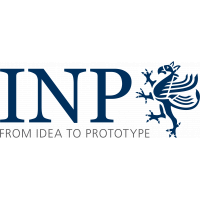Presented data was obtained from the analysis of the impact of the electrode proximity on the streamer breakdown and development of pulsed-driven dielectric barrier discharges (DBDs) in a singlefilament arrangement in a gas mixture of 0.1 vol% O2 in N2 at 0.6 bar and 1.0 bar. The gap distance was varied from 0.5 mm to 1.5 mm, and the applied voltage was adapted correspondingly to create comparable breakdown conditions in the gap. Fast electrical measurements provided insight into discharge characteristics such as the transferred charge and consumed energy. Results show that the proximity of the cathode has a strong impact on the characteristics of the streamer breakdown.
| Field | Value |
|---|---|
| Group | |
| Authors | |
| Release Date | 2022-02-16 |
| Identifier | ed8fe1fe-8503-417e-bc70-1a60ca81971e |
| Permanent Identifier (DOI) | |
| Permanent Identifier (URI) | |
| Is supplementing | |
| Plasma Source Name | |
| Plasma Source Application | |
| Plasma Source Specification | |
| Plasma Source Properties | A symmetric double-sided arrangement with hemi-spherical alumina (Al2O3) covered metal electrodes was used for investigating single-filament DBDs. The thickness of the dielectric barriers was (0.50±0.05) mm and the radius of curvature of their surface was (2.0±0.1) mm. The gap distance between the electrodes was set to 0.5 mm, 1.0 mm or 1.5 mm, respectively, with a maximum error of 3%. The electrodes were implemented in a gas cell made of glass with two lateral quartz glass windows that allowed the observation of the DBDs from the UV to the near-infrared. The cell had a gas inlet at the top and an outlet to a vacuum pumping system at the bottom. |
| Plasma Source Procedure | Before filling the cell with a specific gas mixture, it was evacuated to p<10^(−4) mbar by a turbopump system (Pfeiffer, TSH261), and subsequently an additional membrane pump (Pfeiffer, MVP 020-3 AC) was used as a process pump in a bypass to adjust the pressure in the cell to either 0.6 bar or 1.0 bar. The DBDs were driven by unipolar positive square wave pulses with a repetition rate of 10 kHz and a pulse width of 1 µs. The amplitude of the applied voltage pulses was therefore systematically varied between 4 and 14 kV. The shape of the voltage pulses was specified by the high voltage pulse generator (Behlke, HTS 161-06 GSM) that was supplied by a high-voltage power supply (FUG, HCN 1400-12500) and controlled by a digital delay generator (NI, DG645). |
| Plasma Medium Name | |
| Plasma Medium Properties | A gas mixture of 0.1 vol% O2 in N2 at a pressure of p = 1 bar and p = 0.6 bar, respectively, was used for all experiments. |
| Plasma Medium Procedure | The gas flow through the cell was set to 100 sccm by mass flow controllers (MKS 179B with control unit MKS 647B) connected to gas cylinders (Air Liquide, gas purity 99.999%). |
| Plasma Diagnostics Name | |
| Plasma Diagnostics Properties | Electrical measurements were performed with fast voltage (Tektronix, P6015A) and current probes (custom-build according to https://doi.org/10.1088/1361-6595/aab6d5) and recorded with a digital sampling oscilloscope (R&S, RTO 1044, 4GHz, 20GS/s). The DBDs were observed simultaneously by an iCCD camera (Andor, iStar DH734-18U-A3, resolution: ∆t ≥ 2ns, ∆x ≥ 2µm) and a streak camera system (Hamamatsu, C5680-21C, resolution: ∆t ≥ 20ps, ∆x ≥ 2µm) connected to a long-distance microscope (Questar, QM100, UV transparent). Both cameras were sensitive in the UV and visible spectral range. |
| Plasma Diagnostics Procedure | All data were recorded spectrally-integrated. |
| Language | English |
| License | |
| Public Access Level | Public |
| Contact Name | Wubs, Jente |
| Contact Email |
Data and Resources
- Impact of the electrode proximity on the streamer breakdown (Figure 2a)csv
Electrical characteristics of pulsed DBDs with f_rep = 10 kHz and t_pulse =...
Preview Download - Impact of the electrode proximity on the streamer breakdown (Figure 2b)csv
Electrical characteristics of pulsed DBDs with f_rep = 10 kHz and t_pulse =...
Preview Download - Impact of the electrode proximity on the streamer breakdown (Figure 2c)csv
Electrical characteristics of pulsed DBDs with f_rep = 10 kHz and t_pulse =...
Preview Download - Impact of the electrode proximity on the streamer breakdown (Figure 2d)csv
Electrical characteristics of pulsed DBDs with f_rep = 10 kHz and t_pulse =...
Preview Download - Impact of the electrode proximity on the streamer breakdown (Figure 3a)csv
Electrical properties of the selected DBDs for different gap distances and...
Preview Download - Impact of the electrode proximity on the streamer breakdown (Figure 3b)csv
Electrical properties of the selected DBDs for different gap distances and...
Preview Download - Impact of the electrode proximity on the streamer breakdown (Figure 5a)csv
Comparison of the discharge diameter d_DBD at the rising slope for different...
Preview Download - Impact of the electrode proximity on the streamer breakdown (Figure 5b)csv
Comparison of the discharge diameter d_DBD at the rising slope for different...
Preview Download - Impact of the electrode proximity on the streamer breakdown (Figure 7)csv
Contour plots extracted from streak images illustrating the propagation of...
Preview Download - Impact of the electrode proximity on the streamer breakdown (Figure 8a)csv
Propagation velocity of the cathode-directed streamer at the rising slope...
Preview Download - Impact of the electrode proximity on the streamer breakdown (Figure 8b)csv
Propagation velocity of the cathode-directed streamer at the rising slope...
Preview Download - Impact of the electrode proximity on the streamer breakdown (Figure 9a)csv
Comparison of the streamer propagation velocities at the rising slope for...
Preview Download - Impact of the electrode proximity on the streamer breakdown (Figure 9b)csv
Comparison of the streamer propagation velocities at the rising slope for...
Preview Download

![[Open Data]](https://assets.okfn.org/images/ok_buttons/od_80x15_blue.png)